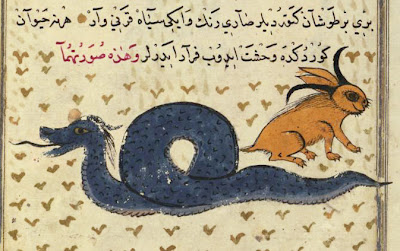parent nodes: Bestiário
Jackalope
vb. criado em 09/05/2013, 21h17m.

Antlered rabbit, hand colored intaglio print by Jacob Xaver Schmuzer, from Instructive and Amusing Pictures for Youth by F.J. Bertuch, c 1803 (from University of Washington Libraries);
The jackalope is a jackrabbit with antelope horns or deer antlers, and sometimes a pheasant's tail and/or hind legs. It is native to the American west. Like many mythical beasts, jackalopes are difficult to study and information about their habits is largely anecdotal. However, they are said to breed only during hail and lightning, and to produce milk with medicinal properties. They are shy, but highly dangerous when threatened. They have even been known to mimic the human voice in order to throw pursuers off their trail - or to join in the mournful campfire singing of cowboys.

The dragon and horned rabbit of Tannin Island, ink and pigments on paper, possibly by the scribe Muhammad ibn Muhammad Shakir Ruzmah-'i Nathani, 1717 (from the Walters Art Museum).
Douglas, Wyoming claims to be the site of the first jackalope sighting, in 1829, and the home of the first taxidermy jackalope, created around 1932. The Douglas Chamber of Commerce issues jackalope hunting licenses, but the jackalope hunting season is only one day each year: June 31. Moreover, the hunter may not have an IQ greater than 72. (They also promote Jackalope Days in June, so I can't figure out whose idea the April 11 date is.) The state of Wyoming has trademarked the name, so I suppose I ought to be writing about the jackalope™ and awaiting a court order to pay a licensing fee. Bah. I don't need their lousy jackalopes when I want horned rabbit chimeras. There are plenty more of those in the world. Here are a few of the jackalope's many relatives.
The Huichol people of central Mexico report a species of antlered rabbit - or possibly a rabbit and deer duo that share antlers back and forth.
From the alpine forests of Bavaria, the wolpertinger has the body of a rabbit or sometimes a squirrel, plus antlers and large fangs and, most notably, wings. The closely related Austrian species is the raurackl.
From the region of Sundsvall in Sweden, the skvader is a mountain hare with the back, wings, and tail of a wood grouse. It was first hunted in 1874, and the first specimen on display dates to 1918, but the creature may have migrated north from the Alps, where it was allegedly described as the "rabbit-bird" by Pliny the Elder in the first century CE. (I couldn't confirm this reference in Pliny, but there have certainly been reports of rabbit-based chimeras in Europe since at least the sixteenth century.)
In central Germany can be found the Rasselbock, another horned rabbit, and from areas of Germany bordering France comes the Dilldapp, which has the
antlers of a deer and the body of a rabbit, ferret, or hamster. It feeds on potatoes.
Rabbit-like beasts with gazelle-like horns are indigenous to Tannin Island… (Wherever that is. Tannin is a word used for "dragon" in the Hebrew Bible.) All I know is that the inhabitants of this Tannin Island presented one of their horned rabbits to Alexander the Great after he saved them from a dragon.
And finally, Zen Master Hakuin Ekaku wrote in 1747 that "The horned rabbit and the furry turtle cross the nowhere mountain," clear proof that a jackalope relative of some sort was known in Japan, too.
f.: aqui
ENCYCLOPAEDIA V. 51-0 (11/04/2016, 10h24m.), com 2567 verbetes e 2173 imagens.
INI | ROL | IGC | DSÍ | FDL | NAR | RAO | IRE | GLO | MIT | MET | PHI | PSI | ART | HIS | ??? 
